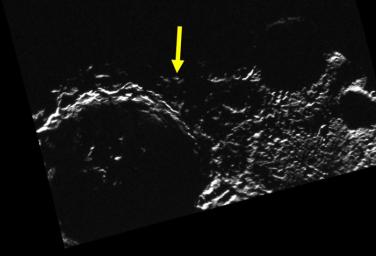
|
There is a Light that Never Goes Out (Almost)
- Click the image above for a larger view
- Full-Res JPEG (1188 x 808) (83.9 kB)
- Full-Res TIFF (1188 x 808) (2.9 MB)
Caption:
Studies of the illumination conditions near the north and south poles of Mercury are of interest because they can be used to determine locations of permanent shadow, extremely cold places where ice deposits lurk. However, the illumination maps also reveal the locations that receive the maximum duration of sunlight during a Mercury solar day. A "peak of eternal light" that is illuminated continuously for an entire solar day would be a favorable target for a lander, because solar power would be available all the time. So far, no such peak of eternal light has been identified at Mercury's south pole. The spot that get the most illumination (about 82%), is located at 89° S, 50.7° E. This place is indicated by the arrow in today's image.
This image was acquired as part of MDIS's campaign to monitor the south polar region of Mercury. By imaging the polar region approximately every four MESSENGER orbits as illumination conditions change, features that were in shadow on earlier orbits can be discerned and any permanently shadowed areas can be identified after repeated imaging over one solar day. During MESSENGER's one-year primary mission, MDIS's WAC was used to monitor the south polar region for the first Mercury solar day (176 Earth days), and MDIS's NAC made repeated images of the south polar region during the second Mercury solar day.
Date acquired:
December 24, 2011
Image Mission Elapsed Time (MET):
233190744
Image ID:
1175166
Instrument:
Narrow Angle Camera (NAC) of the Mercury Dual Imaging System (MDIS)
Center Latitude:
-88.17°
Center Longitude:
35.40° E
Resolution:
298 meters/pixel
Scale:
The large crater is Chao Meng-Fu, about 129 km (80 mi.) in diameter.
Incidence Angle:
91.1°
Emission Angle:
7.1°
Phase Angle:
95.6°
Projection:
Polar stereographic projection centered at 90° S, with
0° toward the top and 180° toward the bottom.
Background Info:
The MESSENGER spacecraft is the first ever to orbit the planet Mercury, and the spacecraft's seven scientific instruments and radio science investigation are unraveling the history and evolution of the Solar System's innermost planet. MESSENGER acquired over 150,000 images and extensive other data sets. MESSENGER is capable of continuing orbital operations until early 2015.
For information regarding the use of images, see the MESSENGER image use policy .
Cataloging Keywords:
| Name | Value | Additional Values |
|---|---|---|
| Target | Mercury | |
| System | ||
| Target Type | Planet | |
| Mission | MESSENGER | |
| Instrument Host | MESSENGER | |
| Host Type | Orbiter | |
| Instrument | Mercury Dual Imaging System (MDIS) | |
| Detector | Narrow Angle Camera (NAC) | |
| Extra Keywords | Color, Crater, Radio, Shadow | |
| Acquisition Date | ||
| Release Date | 2013-04-24 | |
| Date in Caption | 2011-12-24 | |
| Image Credit | NASA/Johns Hopkins University Applied Physics Laboratory/Carnegie Institution of Washington | |
| Source | photojournal.jpl.nasa.gov/catalog/PIA16999 | |
| Identifier | PIA16999 | |
